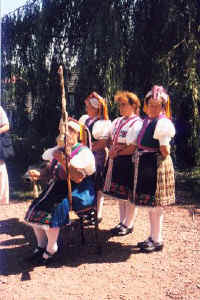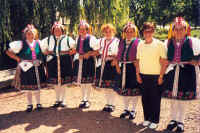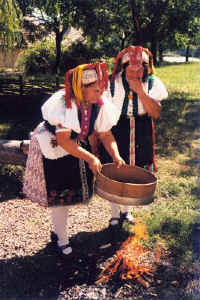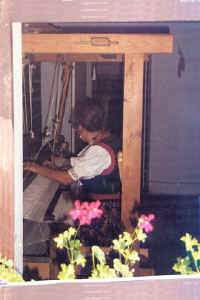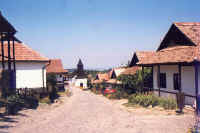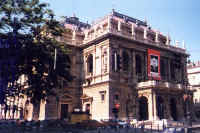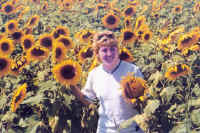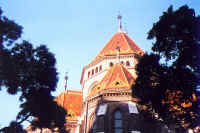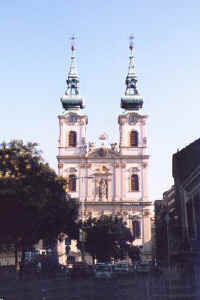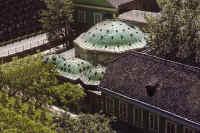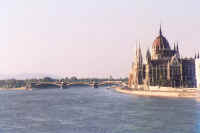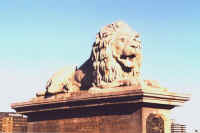|
Budapest - Holloko Thursday, 30 July: The bus left at 9 a.m. for the optional tour to Holloko, a 17th century village on UNESCO's cultural heritage list. It was over an hour northeast of Budapest in the northern highlands near the border with Slovakia. The old village now has only 40 inhabitants, though the newer section adjoining it has 360. According to the guide, the name means "Raven Rock" and is based on an old legend to the effect that a raven prevented some construction that would have ruined the village by appearing every evening and carrying off the stones that the builders had laid during the day. Our group gathered in an open area where we were entertained by six women singing and dancing to their local music. One of them lit a small campfire and popped corn in an open wooden basket. Surprisingly, the basket didn't catch fire, and only a little corn flew out as it popped. She then offered us the popcorn.
After the performance, we all walked around the old village, visiting the tiny, simple St. Martin Church as we passed. Originally none of the houses had chimneys (because chimneys were taxed). Instead, all the houses had openings in the ceilings that allowed smoke to rise into the attics. The gables, front and back, had several decoratively shaped holes cut in them so the smoke could escape. Although the old houses now have chimneys, they retain the decorative holes in the gables. We also visited a shop where flax was spun into thread, then woven into a cloth the village was noted for. The style of agriculture was unusual, too. The land around the village is very hilly. Each "farm" is only a few yards wide, but runs from the bottom of the steep hill to the top. Because crops are planted vertically, it would seem that the rain would wash right down the slope, taking soil and plants with it. But they had been doing it that way for centuries and didn't seem to have a problem with it. After noon we divided into groups of seven or eight for lunch in local homes. Our hostess was the youngest of the dancers we had seen earlier (in center on picture). She was assisted by her mother. Neither of them spoke a word of English, but we got along fine with gestures. We were served family-style, first a broth with a few noodles into which we dumped boiled potatoes and small bits of chicken that were served separately. The main course was chicken paprika, consisting entirely of whole thighs rather than the more common cut up chicken. This was served with a pasta very much like the German spaetzle. Of course, there was wine, too. It was a delicious meal but, as usual, rather much for lunch. Later as we stood outside under a lovely grape arbor, our hostess showed us several chickens she was raising, apparently to be fed to the next group of tourists.
We started back about two, passing by field after field of sunflowers, a major cash crop of the area. On returning to Budapest, the bus was passing right by the Opera House, so we asked to be dropped off there. It was 3:25, just in time for the four o'clock tour. The Opera House was lovely, very ornate, but not too large (seats 1261). It would have been a nice tour except that it was stifling hot inside, even though the weather was pleasant outside. Among other things, we learned the Franz Liszt was born in Budapest of German and Hungarian parents. The Hungarians claim him as their own, even though he left as a child and couldn't speak a word of Hungarian. We intended to see St. Stephen's Basilica next, but stopped at a very upscale gelateria to use the facilities. We reached the entrance to the basilica at 5:04, only to find that it had closed at 5:00. We walked the few blocks back to the hotel. While Jane went to the pool, I walked over to Buda to take photos of Presbyterian Church and St. Anne's, and also the Kiraly Bath, built by the Turks in 1566. Coming back, I got a nice shot of Parliament and the bridge leading to Margit Island, also a close-up of one of the lions on the pedestals at the entrance to Chain Bridge. I got back to the hotel at 6:15. We met the group at 7:30 for the optional Operetta Concert at the Pest Vigado (music hall) two blocks from the hotel. The performers (several different singers and a dancing troupe) were very talented, and we enjoyed it very much. Most of the selection were from German operettas, but there were a couple from Italian and Mozart operas. Interestingly, the tenor who sang only in Italian (including O Sole Mio) was Chinese. The performance ended about 10:20. We hadn't eaten supper (because of the large lunch at Holloko) so we stopped in the Grill for some excellent goulash soup before retiring.
Copyright © 2000-2023 DarrellPeck.com All rights
reserved. | ||||

